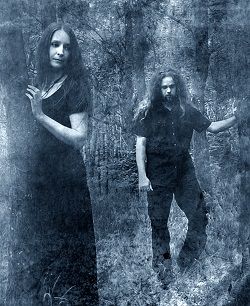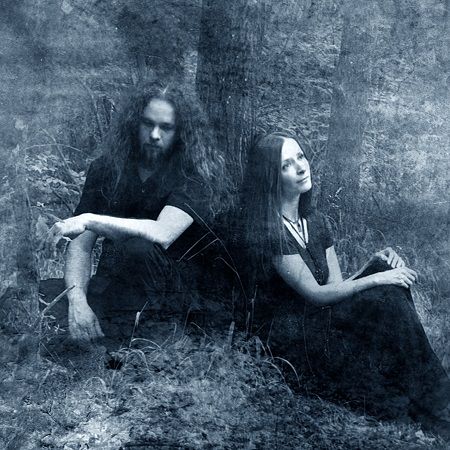
Interview by Alessandra Cognetta
 The Moon And The Nightspirit is a pagan folk duo hailing from Hungary. Mihály and Ágnes have been building over the years an immersive musical experience, enriched by the use of multiple peculiar instruments and lyrics in their mother tongue. Their latest album, “Holdrejtek”, has been released through Prophecy Production and it marks an important milestone in the duo’s career and evolution, which we tried to examine by asking Mihály a few questions about The Moon And The Nightspirit, the role of Nature in their music, working as a duo and the intriguing origins of the morin khuur.
Hello and welcome to Femme Metal, Mihály! It’s a pleasure to feature The Moon And The Nightspirit here. How’s it been going for you since the release of the new album?
The Moon And The Nightspirit is a pagan folk duo hailing from Hungary. Mihály and Ágnes have been building over the years an immersive musical experience, enriched by the use of multiple peculiar instruments and lyrics in their mother tongue. Their latest album, “Holdrejtek”, has been released through Prophecy Production and it marks an important milestone in the duo’s career and evolution, which we tried to examine by asking Mihály a few questions about The Moon And The Nightspirit, the role of Nature in their music, working as a duo and the intriguing origins of the morin khuur.
Hello and welcome to Femme Metal, Mihály! It’s a pleasure to feature The Moon And The Nightspirit here. How’s it been going for you since the release of the new album?
Hello. The pleasure is ours. Thanks for this great interview! We are actually very excited and happy that the new album finally came out under the aegis of Prophecy Productions. We are absolutely delighted with their work so far. We already had many interviews from all over the world and “Holdrejtek” had some really great reviews from magazines of all kind. With the support of Prophecy our music has also reached a brand new potential audience, who were absolutely unaware of our music till now. So far so good, we are very positive nowadays and hoping for the best.
“Holdrejtek” was released not too long ago. How would you describe the album to our readers? What can fans of your previous works expect?We always try to do something that we haven’t done before. Our music changed a lot since the early times. It matured, evolved and was enriched by many new layers. Throughout the years we’ve found our own distinctive voice, and we became better and more experienced songwriters. While the first two albums were a bit of a path-searching ones, we are now sure of the musical way we must tread, that fits us the most, where we can express ourselves in a more complete way. “Holdrejtek” is a bit melancholic, sometimes quite dark, yet very intimate and deep acoustic music with a strong nature-inspired atmosphere. We both think that this is our most matured and diversified album so far.
In addition to releasing your new album, you also reissued some of your old works in digipack format and with revised layouts. “Mohalepte” also has a bonus CD with 3 previously unreleased songs. Can you tell us a bit more about how this all played out?Yes, indeed our previous albums have been re-released with revised layouts designed by Costin Chiorenau. “Mohalepte” also features 3 different interpretations of 3 older songs. We are very happy with the new design and think it was indeed a good idea of Prophecy to make our older, harder to find albums available as well.
You and Ágnes play a variety of instruments, some of which very rare or not well-known. Could you tell us a bit about the most peculiar instrument you used? Why you chose it, how you got around to finding it and, most importantly, what kind of instrument it is.Two of the most peculiar instrument we used is the morin khuur, and the kalimba or in other name thumb-piano. The first one is a mongolian two-stringed bowed instrument and the latter is an African plucked idiophone. I think we first met with the morin khuur, back in a time when we were doing a bit research and reading about the origins of the Huns -our ancestors-, who were a nomadic and spiritual nation originating from somewhere Mongolia. There were some references about a bowed instrument these people were playing on. Let’s give it a try, we thought, and we listened to a video of an old man playing the morin khuur. It was one of the most enchanting and magical sounding instrument we ever heard. In that moment we knew that if we had the opportunity we would buy an instrument like this and learn to play it. Actually it is a very hard to play instrument with a really strange and unique bowing technique. Out of the two of us, only Ágnes can play it. Same goes for kalimba. Love at first sight. It is a small and easy to play instrument with an enchanting fairy-like, tinkling sound.
This leads to another obvious question: how did you both learn to play all of these instruments? What kind of research and training went into it?Though we learned the basics in musical schools, we are both self-taught musicians with a perversion to learn to play as many instruments as possible. 🙂 Our main instruments are the violin -for Ágnes– and the acoustic guitar -for me-. I think we are decent violin and guitar players, but we are of course not masters of all the other instruments -one lifetime wouldn’t be enough for that- and we treat ourselves more like enthusiastic amateurs. However we are trying our best to learn to play them decently.

Our main source of inspiration is Nature itself. It is the whispering of Mother Earth, the long-forgotten tales of the forests, streams and stones that inspires us mostly. We also read a lot of books and listen to all kind of music, from classical to metal. They all inspire us in a way or another.
In addition to writing and performing all the music (aided by live members Gábor Végh and Gergely Cseh), you and Ágnes also mix and master all the recordings. How is it, working as a duo on all the aspects of The Moon And The Nightspirit? What are the pros and cons?Working as a duo is the perfect way for us. We can walk our own musical path, free and unrestricted, without having to make any compromises. We have full control of every phase of the song-writing and recording this way. Since we work in our own studio, we have no time limit and we can freely experiment with various sounds or recording techniques. I honestly don’t think there are any cons.
All the lyrics for The Moon And The Nightspirit are in Hungarian. I think it is a really interesting element, it adds a whole different depth to the music. Sadly, though, I don’t understand Hungarian, so I wanted to ask you what are the lyrics from “Holdrejtek” about? I know it deals with fairytales and folklore, are there any stories in particular that you depicted in the album?The lyrical concept of the new album revolves around the duality and unity of the micro- and the macrocosmos, the hidden depths of seeds and the stellar-manifested universe. The album on the one hand is a dedication to the unseen, yet all-permeating forces that slumber in the arborescent depths, deep inside the growing seeds and blooming burgeons, the secret heart of Nature that throbs in all the creatures of the earth. On the other hand a dedication to the nocturnal, star-veiled, dream-woven face of the world, the secret Nature, the lunar sanctuary, the shelter of the weary and matter-bound spirit and soul.
“It is true, certain, and without falsehood, That, which is below corresponds with that which is above, and that which is above corresponds to that which is below to perform the operation of the magic of One” quote from Tabula Smaragdina.
I noticed that all your album covers, all of which are drawn by Ágnes, fit in the same style (and, personally, I find them all absolutely gorgeous). Is there a common theme the artist followed? What kind of interaction is there between the music and the album artwork?The artworks are Ágnes‘s reflections to the music and the lyrics. They are all strongly connected to the lyrical and/or musical concept of the actual album. Usually this is the last phase of the creative process. When all musical parts are already written and recorded, when the whole album starts to shape into a cohesive form, she starts to paint images evoked by the music. I really adore her works and I think her visual art adds another interesting and unique layer to the world of The Moon And The Nightspirit.
You played a lot of live shows, on many different stages and with different bands. What is, in your opinion, the perfect stage for a The Moon And The Nightspirit performance? Furthermore, how has your experience with the audience been so far?We had great experiences with the audience so far, no matter where we played. I personally prefer the smaller club-concerts, because of the intimacy, but a nighttime open-air stage under the starry dome in a sylvan environment would also be a good option for a band like us.
That was our last question! Thank you so much for being with us, Mihály, we wish The Moon And The Nightspirit all the best! You can leave a message to fans and readers here.Thanks for the support! We hope to meet you on one of our live shows. Blessed be.